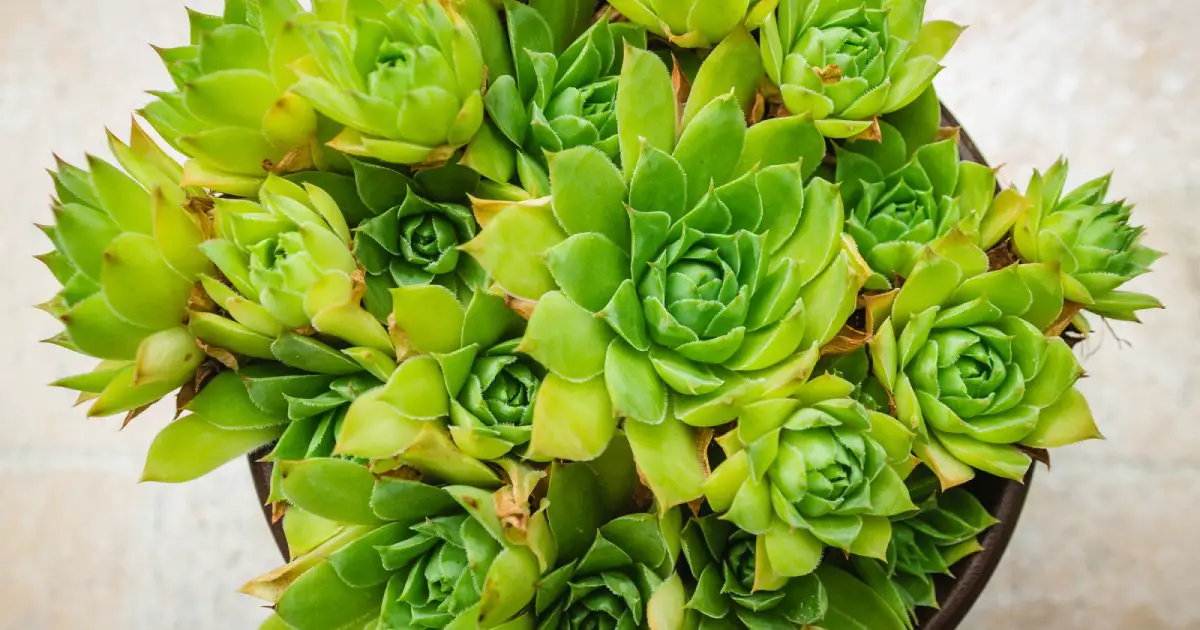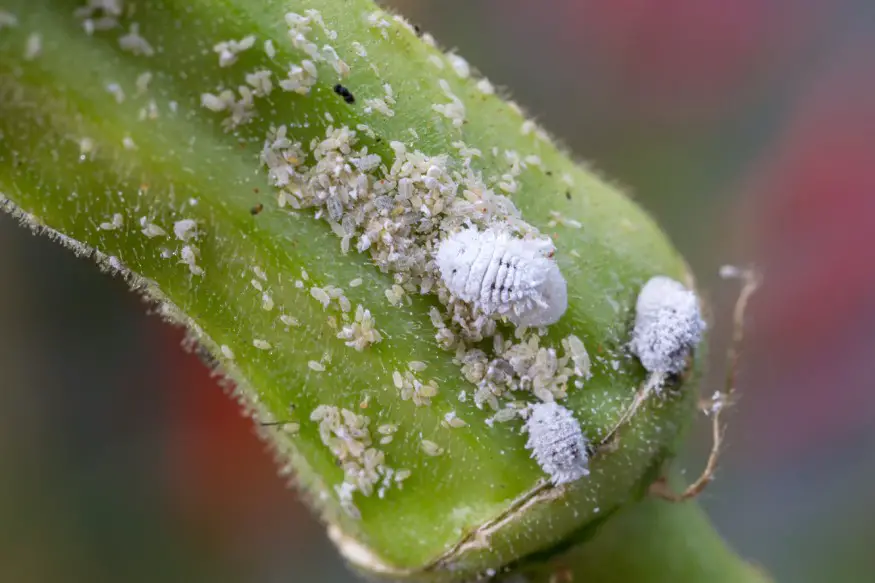Since the 1980s, a hens and chicks plant has been growing on an old tree stump in my grandmother’s flower bed in Indiana, USDA zone 6. Despite annual snowstorms, it has survived forty years or more, without any maintenance, fertilizer, or even soil to grow in.
Sempervivum is just as attractive as resilient, with compact round leaf balls in various colors. Outdoors, hens, and chicks can fill rocky areas where nothing else will grow and add interest to a winter garden, but it can also be a happy houseplant.
With such a wide range of uses, you should consider adding hens and chicks to your nest.

Quick Guide to Hens and Chicks
| Sun requirements | Full sun preferred, partial shade tolerated |
| Hardiness/Zone | Hardy in zones 4+ |
| Water needs | Low |
| Toxicity | Non-toxic |
| Primary growth season | Winter dormancy when planted outdoors in colder climates |
| Typical size at maturity | Leaf balls typically less than six inches tall, but can spread as ground cover indefinitely |
Identifying Your Hens and Chicks
Hens and chicks succulents got their name because they self-propagate through offsets. In the summer, the plant goes through a major bloom, in which the mother plant grows tall (as though becoming leggy) and dies, but only after putting out numerous shoots. At the end of each shoot, a chick grows in a pattern similar to a strawberry plant.
However, this descriptive name has the unfortunate consequence of creating confusion because there are two completely different types of succulents that are both commonly called hens and chicks.
Sempervivum, the focus of this article, is the cold-tolerant variety. Echeveria, which looks very similar to Sempervivum, is a more typical succulent regarding its care needs. For example, lipstick echeveria is only viable as an outdoor plant in USDA growing zone 9b+.
Note: Although they are very similar in their range of shapes, colors, and offsets, Sempervivum typically has rough, spiky leaf edges like aloe. On the other hand, echeveria tends to have smooth-edged leaves (other than perhaps one point at the center of the leaf edge). Echeveria’s leaves also tend to be wider and thicker, with a looser rosette.
There are many species and cultivars of Sempervivum in different colors and variations. Some develop a white, hairy, cobweb-like fuzz on the tops of the rosettes, for example.
Growing Requirements for Sempervivum
Where to Plant

Pet Access
Hens and chicks are considered pet-safe succulents (both Sempervivum and Echeveria). In addition to not being toxic for people or pets, they typically don’t attract the interest of hungry pets due to the leaves rough, spiky edges and the compact shape of the rosettes.
Indoor Placement
Hens and chicks do fine indoors, although they are more common outdoors. While they will do best in the direct sunlight of a south-facing window, they may tolerate a bright north, east, or west-facing window.
A healthy hen and chick is compact like a ball, except in the summer when the mother plant blooms, grows dramatically, produces offsets, and dies. If your Sempervivum is getting leggy at any time other than the summer, you need to move it to a location with better sunlight.
Note: Even though your Sempervivum can tolerate less than full direct sunlight, it’s best to give it as much light as possible. When Sempervivum gets plenty of light, they tend to develop more attractive coloration on their leaves.
Outdoor Placement
Since hens and chicks are cold tolerant in zones 4+, it is more common to find them thriving in the ground than other succulents (which often do better when planted in a pot and brought indoors for the winter).
These are such undemanding plants; thanks to their shallow roots, you can grow them almost anywhere. You can have a healthy and happy Sempervivum even in areas with poor, rocky soil (or, like my grandmother, you can even grow them on a stump!).
Plant your hens and chicks in an area with as much sun as possible to ensure their health and maximize color variations. They should be fine as long as they get at least a few hours of direct sunlight each day.
Container and Soil

As mentioned, hens and chicks have very shallow roots. If you are not going to grow them directly in the ground, we recommend growing them in a shallow planter with four inches of potting soil.
Note: The downside of using a deeper pot is that the potting mix in the bottom of the planter may stay wet long after the potting mix the plant’s roots can easily dries out, resulting in under-watering.
If you have a typically-proportioned pot you want to use, you can try using our ‘pot in a pot’ method.
- You will need a shallow plastic pot with the same diameter as the decorative container.
- Plant your Sempervivum in the plastic pot.
- Then, nest the plastic container inside the decorative pot.
If your plastic pot is too small to stay at the top, you can put rocks inside the decorative pot for support.
If your decorative pot doesn’t have drainage holes, remove the plastic pot before watering and let it fully drain. This way, water doesn’t accumulate in the bottom of the decorative pot.
Commercially available cactus/succulent-specific potting mixes will work fine for Sempervivum, but we encourage you to make your own potting mix. It is healthier for your succulents than the potting mix from your local big-box store (which tends to be too high in organic matter). Plus, it’s also cheaper.
You don’t have to be strict about the ratios, but a good basic recipe for succulents is:
- Two parts potting soil, ideally a cactus blend,
- One part coarse sand, and
- One part gritty amendment (such as perlite or pumice).
Hens and chicks do so well in poor, rocky soil. If you want to save money, you can even drop the potting soil down to one part or increase the gritty amendment to two parts.
Watering
As you might expect from a plant that originates in rocky, alpine soil, your Sempervivum needs loose, well-draining soil and limited watering. Overwatering and poor drainage can lead to root rot and pest infestation.
Typically, outdoor Sempervivum goes dormant over the winter; indoors, they grow slowly year-round. You don’t need any watering if they are outdoors, except during a hot, dry summer. Indoors, only water on an as-needed basis or when the pot dries out.
Note: We recommend using the “soak and dry” method for potted hens and chicks. Remember that a shallow planter dries out faster than large, deep pots, meaning you will need to water your Sempervivum more frequently. More so during the summer, when more water is lost to evaporation.
For more information on the “soak and dry” watering technique, check out our complete guide to watering succulents. It includes a tracking card for watering, fertilizing, and other succulent care.
Fertilizer and Maintenance

Hens and chicks are accustomed to poor, rocky soil, so they don’t need a lot of fertilizer. If you repot a Sempervivum in a planter, don’t bother fertilizing the first year, as the fresh soil will have plenty of nutrients.
In subsequent years, or if you plant Sempervivum directly into poor outdoor soil, a light fertilizing now and then can’t hurt. When you do fertilize, perhaps once or twice annually, use a liquid fertilizer, preferably organic.
Note: If you use liquid chemical fertilizer for houseplants but not succulents specifically, dilute to at most half-strength (quarter-strength is best). If you’re using an organic fertilizer formulated specifically for cacti or succulents, follow the package instructions regarding any necessary dilution.
Hens and chicks don’t need a lot of maintenance other than propagating the offsets. The one thing you’ll want to do is to remove the dead mother plant after it finishes its summer bloom and offset production.
Typically you’ll only need to repot hens and chicks to address overcrowding of the pot due to offsets, but it isn’t a bad idea to do so every few years to freshen up the potting mix.
Hens and Chicks Propagation

You don’t propagate hens and chicks, hens and chicks propagate themselves. Wait until the summer when your mother plant produces offsets, and each can become a whole new Sempervivum.
You have two options for growing new plants from your offsets. One is to leave the offsets attached to the mother until the mother dies. Then, you remove the mother plant and leave the offsets where they are rooted. This is the easiest method if your Sempervivum is growing in the ground.
The second option works best if you use your Sempervivum offsets to create a bunch of new plants rather than letting them spread. Specifically, once the offsets have taken shape, you can remove them from the mother plant (sever the shoot with a sharp, sterile set of clippers or knife) and replant each offset in its own pot.
The advantage of this method is that the mother plant may not die if she doesn’t have to give all her energy to her demanding offspring. This method may also be necessary if your mother plant is in a narrow-mouthed pot without any room for babies.
Check out our propagation guide for more detailed explanations of propagating offsets and other techniques.
Common Hens and Chicks Problems

Like most succulents, hens and chicks are pretty resilient and low maintenance, but there are a few problems to watch out for:
- Stretching: It is normal for a mother plant to become tall and leggy during the summer when she produces offsets. However, if your Sempervivum becomes leggy at other times of the year, you need to move it to a location with more sunlight.
- Losing color variation: If your newly purchased Sempervivum was beautifully variegated, including purple, brown, or dark green parts of the leaves in addition to the lighter green base, but is now a uniform pale green, the problem once again is inadequate sunlight.
Move your plant to an area with at least a few hours of direct sunlight daily, and the coloration should improve. If you are growing it in a pot indoors, consider taking it outside to grow in a sunny spot each summer. - Mealybugs: Hens and chicks’ compact rosettes are attractive to mealybugs, and you will likely not see the mealybugs until you have a pretty bad infestation. Fortunately, mealybugs on succulents can often be controlled using easy techniques and organic products.
- Leaves or roots are brown and mushy: Rot results from overwatering, inadequate drainage, and insufficient sunlight. You may need to address all three issues by repotting, relocating, and reconsidering your watering schedule.
Preparing Your Nest for Hens and Chicks
All you need is a sunny spot in your garden or a shallow pot on a sunny windowsill, and you can grow a happy Sempervivum. They make an excellent ground cover in rocky areas, even in cold climates. Just remember to meet its basic needs, and your hens and chicks will reproduce like rabbits, creating offsets every year so you can expand your brood.
